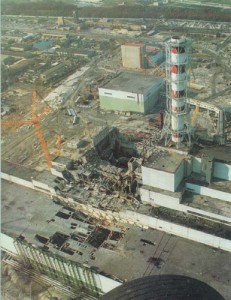The gaping maw of Chernobyl.
 Absent
some terrible news from Japan this will be my second and last column
about the nuclear accidents unfolding there. It turned out I was right
last time about the sodium polyboride or boric acid or whatever neutron
absorber the Japanese authorities dumped in first one and now two
reactors along with a lot of sea water in an attempt to quench the
reaction heat. I think it is pretty clear, too, that most of these
reactors will not be coming back online… ever. This column looks at what
that can mean for the nuclear industry in Japan and I also want to look
at how these accidents are or aren’t like Chernobyl — a comparison I am
seeing far too often in news reports.
Absent
some terrible news from Japan this will be my second and last column
about the nuclear accidents unfolding there. It turned out I was right
last time about the sodium polyboride or boric acid or whatever neutron
absorber the Japanese authorities dumped in first one and now two
reactors along with a lot of sea water in an attempt to quench the
reaction heat. I think it is pretty clear, too, that most of these
reactors will not be coming back online… ever. This column looks at what
that can mean for the nuclear industry in Japan and I also want to look
at how these accidents are or aren’t like Chernobyl — a comparison I am
seeing far too often in news reports.To come up with a good comparison I turned to my friend Robert Bishop, one of the only Americans actually at Chernobyl back in 1986, helping fight that reactor.
These Japanese reactors are old and fairly well understood while Chernobyl was brand new. These Japanese reactors had already been in service for 16 years when Chernobyl melted down. In comparative terms there is no comparison — Chernobyl was vastly worse.
As just one example, when it came to poisoning the nuclear reaction in Japan they inserted the control rods, dumped-in the boric acid, then allowed sea water to enter the containment. In the course of all this the roof of the reactor building exploded revealing the containment vessel, inside of which lay the reactor core. But at Chernobyl it was all so much simpler — no reactor building, no containment vessel, just the out-of-control reactor, standing in the rain, emitting radiation.
Poisoning Chernobyl, according to Robert, came down eventually to dumping tons of powdered bismuth directly into the gaping maw of the reactor core from above. “It was almost instantaneous, ” he recalled. “Bismuth is a good neutron absorber, but more importantly it went through two complete phase changes from solid to liquid to gas, absorbing huge amounts of heat from the core, which was cooled by hundreds of degrees in just seconds. ”
It was a clever gambit, poisoning Chernobyl, but remember that somewhere between 30 and 60 workers died in the process leaving a further legacy of birth defects in the region.
These Japanese nuclear accidents come down to the simple fact that nobody back in the 1960s designed nuclear plants to run for 40 years then go through an 8.9 earthquake. Nor are today’s nuclear plants probably designed to that standard, which means Japan is facing what will by necessity be a significantly different nuclear future.
We’ll see rolling blackouts for months, maybe years, in Japan and the new nuclear plants that replace those old nuclear plants will be vastly different, too. If I were to predict a clear winner in Japan’s new nuclear future it would be Toshiba with its innovative 4S (Super Safe Small and Simple) reactors.
Japan needs increased generating capacity fast. They would like to replace nuclear with nuclear. But the new plants also have to show they can survive an 8.9 earthquake and reduce the number of critical failure points. Toshiba’s 4S reactors, which have been around for several years now, though not yet commercially successful, do all that quite easily.
4S reactor cores are like nuclear building blocks, built on a factory production line and transported by truck to be installed 30 meters under the ground. Each 4S puts out 10 megawatts of electricity or enough for 2000 Japanese homes. Following this path means the lost 1000 megawatt reactors will need 100 4S’s each to replace them or a total of 1200 4S reactors. 4S’s are fueled at the factory, put in place to run for 20 years then returned to the factory for refueling. They are sodium-cooled and pretty darned impossible to melt down. If the cooling system is compromised they automatically shut down and just sit there in a block of sodium.
The biggest problem facing the 4S has been regulatory approvals, which would normally take in aggregate 100 times as long (and cost 100 times as much) if done the same way as a larger nuclear plant. That’s where this earthquake will probably change everything, at least in Japan, where the process will be streamlined almost to nothing with a 4S soon stashed under every power substation giving Japan a smart grid in the process.
By Robert X. Cringely

No comments:
Post a Comment